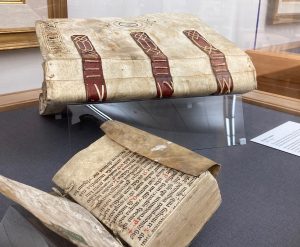 This month, the Special Collections reading room is hosting a student-curated exhibit. “Medieval Bookbindings: Methods, Materials and Oddities” looks at examples of medieval binding structures from Special Collections’ holdings of early printed books and manuscripts dating from the 13th through 16th centuries. The exhibit was curated by Louisa Eastley, a student employee in the Lee Library’s conservation lab. To view the exhibit, reading room access is required; the exhibit will be on display through April and May 2022.
This month, the Special Collections reading room is hosting a student-curated exhibit. “Medieval Bookbindings: Methods, Materials and Oddities” looks at examples of medieval binding structures from Special Collections’ holdings of early printed books and manuscripts dating from the 13th through 16th centuries. The exhibit was curated by Louisa Eastley, a student employee in the Lee Library’s conservation lab. To view the exhibit, reading room access is required; the exhibit will be on display through April and May 2022.
March 24, 2022 by Ben Harry
At the BYU Motion Picture Archive we have a variety of historical materials.
Sometimes these are Hollywood film artifacts: film prints of Hollywood-produced films. Some of these are common (CASABLANCA) and some of these are rare (WINGED VICTORY).
A special group of materials are those absolutely unique camera original elements of productions from the BYU Motion Picture Studio. From these original elements we can now scan with cutting edge technology and see the films of yesteryear as they have never been seen before.
This is film restoration: to go back to a purer source of information so that what was there in the beginning can be brought back and enjoyed in its fulness (ring a bell?).
I could do this work alone, but that would miss out on the great work of the university: contributing to the growth of the next generation. So the library has generously afforded me to offer internships in film restoration at times. Together, the students and I work to restore titles for which we have the original film materials.
On April 1, we are holding our next RESTORATION SHOWCASE, where these students will present the projects we have been working on.
2001: The Deal (1980)
Short student project from the Theatre and Communications school.

“Time Bomb” music video (1984)
We honestly have no information on this music video. We are guessing on the song title based upon the chorus lyrics. The performers might have been called “The X-ing Band”

AS THE TWIG IS BENT (1958)
A young man is concerned for his family’s eternal duration when he perceives his father’s smoking habit to be at odds with priesthood sealing requirements.

YOU WILL NOT WANT TO MISS THESE.
Historical. Fun. Interesting. Entertaining.
Join us, and some special guests, as we take a walk down memory lane with newly-restored media as it has never been seen before.
To celebrate International Women’s Day, the L. Tom Perry Special Collections shares the work of 20th century bookmaker Edna Rudolph Beilenson (1909-1981).
Edna Beilenson’s husband Peter founded the Peter Pauper Press, and after their marriage, she worked alongside him as a typesetter. Her career expanded into printing, publishing, and book design. In the 1930s, Beilenson organized a group of women who were involved in printing and the graphic arts into a sort of collective called The Distaff Side.
Their first production was a book called Bookmaking on the Distaff Side (1937). Each signature of the book—31 in total—was printed by a different member. It includes essays (ranging from scholarly to satirical), literature, and artwork commenting on the overlooked contributions of women in the book trades throughout history. The Distaff Side worked sporadically over the ensuing decades toward charitable causes, including organizing a book fair to raise relief funds for Britain in the early years of World War II. Their third and final book, A Children’s Sampler, was published in 1950 to benefit a children’s medical charity.
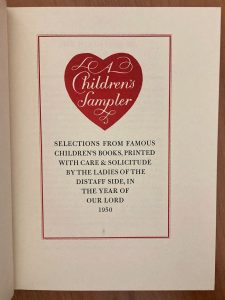
Title page of A Children’s Sampler
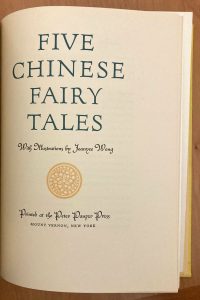
Edna Beilenson’s contribution to A Children’s Sampler
Beilenson edited a series of cookbooks published by the Peter Pauper Press during the 1950s. She became sole proprietor of the company after her husband’s passing in 1962. Beilenson was active in many organizations related to the printing profession, and she was the first woman to serve as president of the American Institute of Graphic Arts. She also designed and printed two different titles for the Limited Editions Club book series. More information about Beilenson can be found in Sean Donnelly’s history, The Peter Pauper Press of Peter and Edna Beilenson (University of Tampa Press, 2013), available in Special Collections.
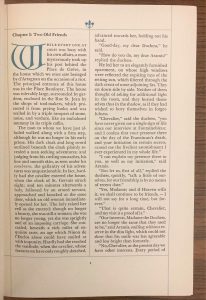
The Man in the Iron Mask, printed by Edna Beilenson for the Limited Editions Club, 1965.
February 23, 2022 by Ben Harry
We are happy to announce our next installment in the ARCHIVE CLASSICS series.
This series features the presentation of cinematic gems held in the BYU MOTION PICTURE ARCHIVE.
These films are esteemed to be of particular importance to BYU Students, focusing on depictions, representations, and expressions of latter-day saints in the medium of the cinema.
The plan for the series is to hold one screening per academic semester and include a presentation that will place them in their time and context.
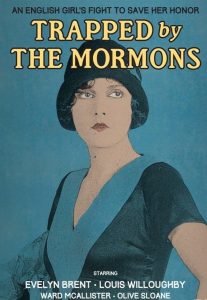
In the first quarter of the 20th century there were some organized waves of anti-Latter-day Saint activities in Britain. One of the mediums they put to use was that of the motion picture, and this belongs to that category.
Sensational, supernatural, strange, and in the end, quite funny—this film had an impact when it was released in March of 1922. On its 100th birthday, the Motion Picture Archive is pulling this relic back out of the mothballs and presenting it for presentation.
There is incredible history with this film, and too much to put in a blog post. Multiple articles have been written about this film, its influence and impact.
Come see it with an audience and hear from Brian Cannon, faculty member in the History Department at BYU, to put this film into its artistic and historical context.
This is one you don’t want to miss!
Friday, March 4, 7pm – Library Auditorium
February 11, 2022 by Ryan K. Lee •
Baker City,
correspondence,
ephemera,
German business,
German immigrants,
Heilner family,
immigration,
Jewish,
Oregon,
Photographs
L. Tom Perry Special Collections is pleased to announce the availability of a newly digitized collection: Sanford Joseph Heilner and Claire Heilner Freedman collection on the Aron Heilner family (MSS 6721). This collection is a wonderful resource for understanding 19th century Jewish German immigrant history in the American West. Some descendants of Aron Heilner, including Sanford and Claire, became members of The Church of Jesus Christ of Latter-days Saints.
The following is a description of the collection by Morgan Meik and Aubrey Stewart, students in the Lee Library Digitization Lab who assisted in scanning this collection:
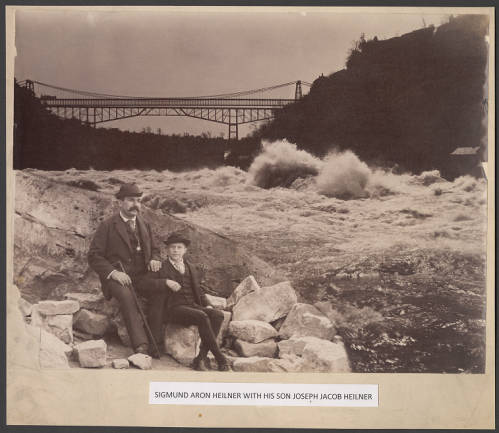
Sigmund Heilner with son (circa 1892)
The records of the Heilner family collection belonged to Sigmund Heilner, an ambitious Jewish German immigrant seeking to make his mark in the United States. They give a firsthand look at Sigmund’s family interactions within the United States and between those who lived in Germany. Additionally, the collection features letters, journal entries, business documents, and other historical clippings pertaining to Sigmund’s business endeavors. The collection was compiled by Claire Heilner Freedman and Sanford Joseph Heilner—two descendants of Sigmund and avid genealogists who added their own commentary throughout the collection. Their writings offer their unique perspectives through their attempts to craft a holistic narrative of Sigmund Heilner’s life.
The collection follows the triumphs and highpoints of Sigmund and his family. These include Sigmund’s marriage, his business endeavors, and his eventual election as mayor of Baker City, Oregon. Correspondence between Sigmund and his family highlight their lives in Germany, such as his brother David’s business successes. The collection also documents a series of tragedies within the Heilner family: the destruction of the theater owned by Sigmund, complicated family relationships, and the murder of Sigmund’s brother Seligman. Perhaps most heart-renching is the ominous forecomings of the Holocaust and its devastating results on the Jewish Heilner family in Germany.
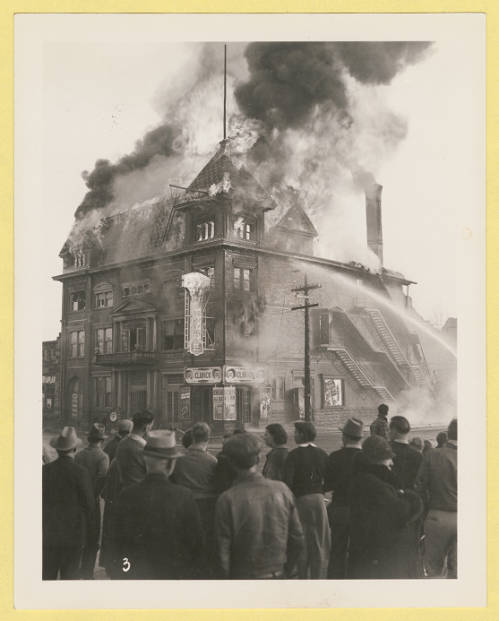
Signmund Heilner’s theater on fire (1937)
In the midst of extreme highs and lows, the Heilner collection offers a unique history of a family attempting to thrive in a confusing and sometimes cruel world. It’s a story of heartbreak, loss, hope, and perseverance—a story that has stood the test of time and remains relevant today.
In addition to a beautifully compiled narrative, the Heilner family collection offers valuable firsthand information for a variety of research topics. These topics include European immigration to the United States, contrasts in German and American business styles, life on the American west coast in the 20th century, and social dynamics among multigenerational families.
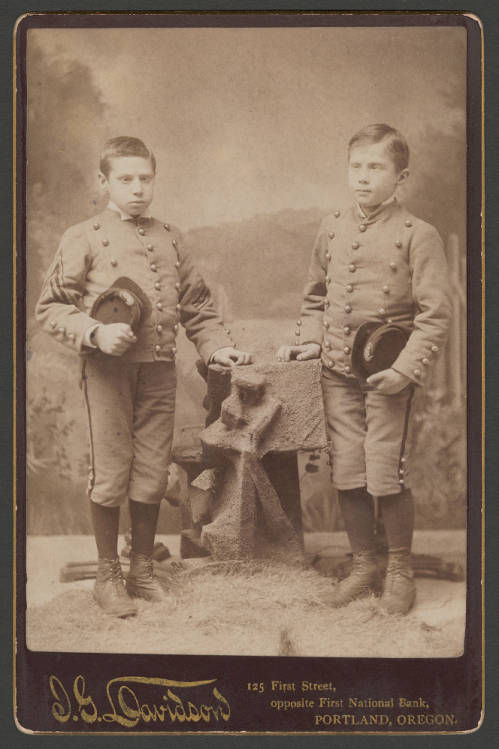
Jesse and Joseph Heilner, descendents of Sigmund Heilner (circa 1887)
EXCITING NEWS:
Selections of letters from this collection will soon be made available alongside thousands of other letters related to German immigration to the United States through the German Heritage in Letters online digital collection, a project by the German Historical Institute in Washington, D.C.
Feb. 10 marks the 200th anniversary of the birth of Victorian writer Eliza Lynn Linton. Lynn Linton is considered the first female salaried journalist in England. Her writing career was profitable but not without controversy.
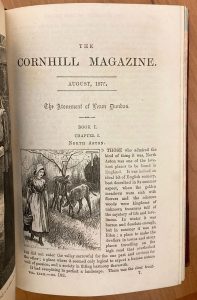
The Atonement of Leam Dundas was serialized in The Cornhill from 1875 to 1876
Elizabeth (Eliza) Lynn was largely self-taught, the youngest child of a widowed clergyman who had free rein to peruse her father’s library. She left home for London at 23 intending to make her way as an author. She published two novels before joining the staff of The Morning Chronicle in 1848. After her third novel, Realities, was panned for its shocking depiction of the life of a stage actress, Lynn turned to journalism full time. She contributed hundreds of articles to newspapers and magazines, including the Literary Gazette, The Cornhill, and Charles Dickens’ Household Words, over the course of her career. She worked for several years as a foreign correspondent in Paris, where she met engraver William James Linton, a widower with seven children. Lynn married him in 1858 but they soon grew apart, ultimately separating in 1867.
After her marriage, she wrote under the name E. Lynn Linton, keeping her maiden name equally prominent with her husband’s. She continued to write essays, articles, and short fiction for periodicals and resumed writing novels including the highly popular romance The Atonement of Leam Dundas (1876) and the controversial True History of Joshua Davidson (1872), which critiqued the Church of England.
Though Lynn Linton lived most of her life independently, paradoxically, she grew increasingly conservative and became a vocal critic of women’s rights. Her strident articles in the journal Saturday Review were collected in 1883 as ‘The Girl of the Period’ and other Social Essays. The New York Times remembered her complicated legacy at her death in 1898: “Her dislikes were many, not to persons, but toward modern society ways, thoughts, and manners…. It is difficult to understand how a sweet-faced old lady with white locks, gold spectacles, and a placid manner wrote such sharp, incisive words.”
The L. Tom Perry Special Collections has a long history of collecting the output of the major French humanist printers of the 16th century. Our vaults hold extensive collections of the work of the Estienne (Stephanus) family, Simon de Colines, Josse Badius Ascencius, and Christophe Plantin. These printers helped spread Renaissance and humanist learning throughout Europe, most often through the output of their printing presses, but sometimes through their own work as scholars and textual editors. They issued Greek and Latin texts in new, updated editions based on recently-discovered manuscripts. They also printed new works by scholars across Europe in many subjects, including Biblical studies, language and literature, medicine, and science. Special Collections actively acquires examples of these printers’ works with an eye to documenting their impact on European history and culture as well as the history of printing and typography.
This post features a few recent acquisitions: first, two examples printed by Simon de Colines (whose press was active in Paris, 1520-1546). Colines likely studied at the University of Paris and worked at the press of Henri Estienne. When Estienne died in 1520, Colines married his widow and assumed management of the press until the oldest Estienne son, Robert, could take over the family business. Colines then set up his own shop nearby and continued to establish his stepsons in the printing trade.
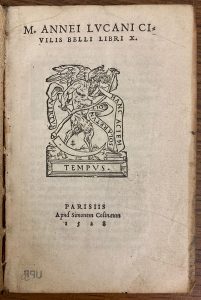
Colines’ “Satyr” pressmark on the title page of an edition of Lucan, 1528.
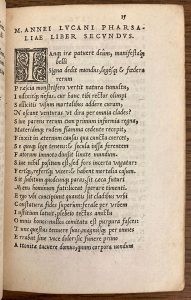
The 1528 edition of Lucan was the first book printed in Colines’ italic typeface.
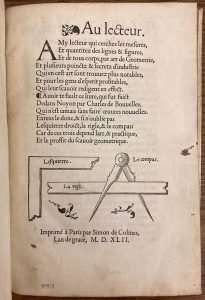
Illustrated title page of Bovillus’ Liure singulier & vtile touchant l’art et pratique de geometrie (Colines, 1542).
Next, two new acquisitions from the press of Christophe Plantin (active 1545-1589). French-born Plantin apprenticed as a bookbinder, setting up shop in Paris in 1545. In 1548, he moved the major commercial center of Antwerp, and quickly gained acclaim as a binder. He expanded his business to publishing, printing, and typefounding. Plantin’s books found markets in France, Belgium, and the Netherlands.
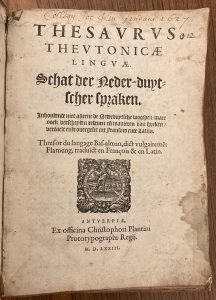
Title page to a Dutch-French-Latin dictionary edited and printed by Plantin between 1567 and 1573.
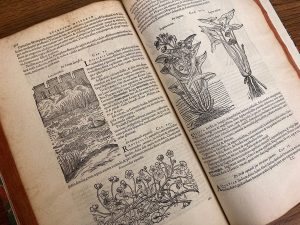
A page spread from Rembert Dodoens’ “Stirpium historiae” printed by Plantin in 1583. This botanical work features extensive woodcuts by Flemish artist Pieter van der Borcht.
During late 2021, libraries, museums and universities around the world celebrated the 450th anniversary of the birth of astronomer Johannes Kepler. Kepler was born December 27, 1571 near Stuttgart in modern Germany.
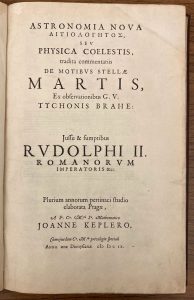 Kepler is best known today for his three laws of planetary motion, developed from years of studying the motion of the planet Mars. He was able to improve on the Copernican model of the solar system by describing how planets move around the sun in elliptical orbits. Kepler also formulated the mathematical rules which govern the speed and size of a planet’s orbit.
Kepler is best known today for his three laws of planetary motion, developed from years of studying the motion of the planet Mars. He was able to improve on the Copernican model of the solar system by describing how planets move around the sun in elliptical orbits. Kepler also formulated the mathematical rules which govern the speed and size of a planet’s orbit.
Kepler described his laws of planetary motion in two different books, Astronomia nova (New Astronomy, 1609) and Epitome Astronomiae Copernicanae (Summary of Copernican Astronomy, 1618). The L. Tom Perry Special Collections owns copies of both titles, along with a number of other early works by Kepler.
Christmas Day 2021 marks the 250th anniversary of the birth of writer Dorothy Wordsworth, younger sister of poet William Wordsworth. Dorothy’s reputation as a writer was long overshadowed by her brother, but with the publication of her diaries and letters in the mid-twentieth century, scholars and critics have re-evaluated the importance of her writing and her contributions to the Romantic movement.
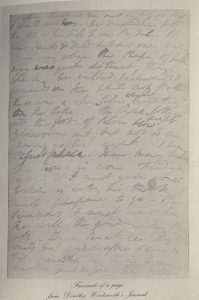
Facsimile of a page from Dorothy Wordsworth’s journals, edited by Ernest De Selincourt.
Dorothy was a keen observer of nature, people, and the landscapes she encountered at home and in her travels. Her journals have often been studied for the relationship between Dorothy’s journal entries and William’s poetry. Dorothy’s own travel writings, such as her “Recollections of a Tour Made in Scotland” and her description of ascending Scafell Pike, have also garnered the attention of modern scholars, as has her correspondence with other Romantic writers in the Wordsworth circle.
The Rowe Collection of William Wordsworth actively collects the work of Dorothy, including published editions of her writing, and biographies, criticism, and other secondary works. Researchers can find out more on the Rowe Collection website under the Dorothy Wordsworth tab.
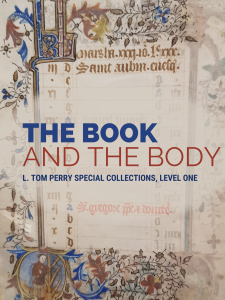 Dr. Elliott Wise’s Fall 2021 Art History 490/540 class are guest curators of the newest exhibit in Special Collections. “The Book and the Body” showcases the students’ original research using images from Special Collections’ printed and manuscript Books of Hours. The exhibit examines how early readers would have interacted emotionally, spiritually, and physically with these illustrated books within the context of everyday devotional practices.
Dr. Elliott Wise’s Fall 2021 Art History 490/540 class are guest curators of the newest exhibit in Special Collections. “The Book and the Body” showcases the students’ original research using images from Special Collections’ printed and manuscript Books of Hours. The exhibit examines how early readers would have interacted emotionally, spiritually, and physically with these illustrated books within the context of everyday devotional practices.
“The Book and the Body” will be on display in the reading room now through January 31, 2022.
 This month, the Special Collections reading room is hosting a student-curated exhibit. “Medieval Bookbindings: Methods, Materials and Oddities” looks at examples of medieval binding structures from Special Collections’ holdings of early printed books and manuscripts dating from the 13th through 16th centuries. The exhibit was curated by Louisa Eastley, a student employee in the Lee Library’s conservation lab. To view the exhibit, reading room access is required; the exhibit will be on display through April and May 2022.
This month, the Special Collections reading room is hosting a student-curated exhibit. “Medieval Bookbindings: Methods, Materials and Oddities” looks at examples of medieval binding structures from Special Collections’ holdings of early printed books and manuscripts dating from the 13th through 16th centuries. The exhibit was curated by Louisa Eastley, a student employee in the Lee Library’s conservation lab. To view the exhibit, reading room access is required; the exhibit will be on display through April and May 2022.















 Kepler is best known today for his three laws of planetary motion, developed from years of studying the motion of the planet Mars. He was able to improve on the Copernican model of the solar system by describing how planets move around the sun in elliptical orbits. Kepler also formulated the mathematical rules which govern the speed and size of a planet’s orbit.
Kepler is best known today for his three laws of planetary motion, developed from years of studying the motion of the planet Mars. He was able to improve on the Copernican model of the solar system by describing how planets move around the sun in elliptical orbits. Kepler also formulated the mathematical rules which govern the speed and size of a planet’s orbit.
 Dr. Elliott Wise’s Fall 2021 Art History 490/540 class are guest curators of the newest exhibit in Special Collections. “The Book and the Body” showcases the students’ original research using images from Special Collections’ printed and manuscript Books of Hours. The exhibit examines how early readers would have interacted emotionally, spiritually, and physically with these illustrated books within the context of everyday devotional practices.
Dr. Elliott Wise’s Fall 2021 Art History 490/540 class are guest curators of the newest exhibit in Special Collections. “The Book and the Body” showcases the students’ original research using images from Special Collections’ printed and manuscript Books of Hours. The exhibit examines how early readers would have interacted emotionally, spiritually, and physically with these illustrated books within the context of everyday devotional practices.